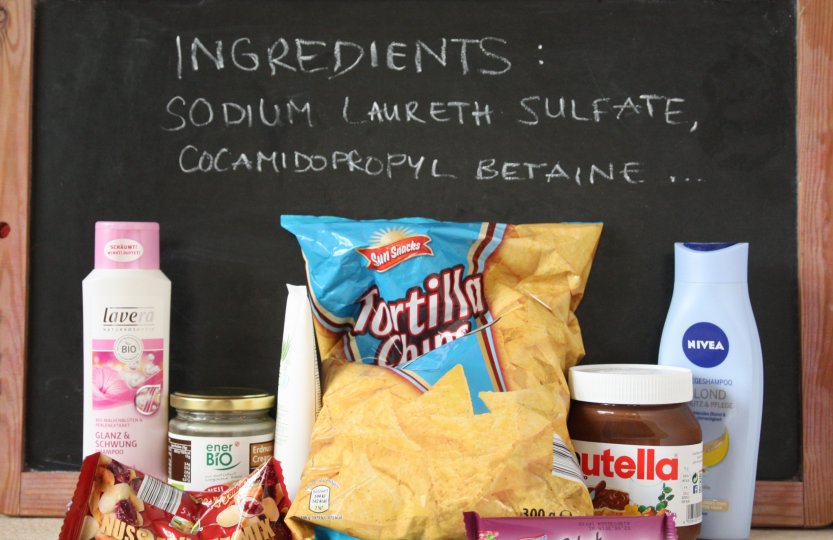In my last article, I wrote about palm oil and the problems with this substance found almost everywhere. Instead of only writing about the problems I decided to take action and have a closer look at how palm oil is influencing my daily life. So, let’s begin with the facts.
To find out when I consume palm oil, I had to do some research. What exactly is the term for palm oil, written in the very thin and very small letters at the back side of shampoo bottles or sizzling plastic bags? Actually, there are more than 200 names which hide the original ingredient palm oil: They can be cryptic like Caprylic triglyceride or they sound like the short names of diseases for example APG or BTMS. A lot of food products for instance don’t use the term palm oil but the much broader term “vegetable oil”. But the most common designations I stumbled upon were Sodium Laureth Sulfate and nebulous circumscriptions containing the word “Coco” or “Coca” – like Cocamidopropyl Betaine and Cocamide MEA. My self-experiment thus consisted of many looks at the backside of packaging and sometimes almost frustrating research for unknown words and terms.
So, my week of tracking palm oil in my life starts on Monday, already at breakfast time: Normally, I prepare a porridge with some fruits. To make it a little bit tastier, I add a teaspoon of peanut butter – which in my case contains “palm fat from certified organic agriculture.” This would be the first thing to delete from my daily food then. I am skiing this week, so instead of having a proper lunch, there is this genius invention of granola bars. Here I find palm oil as an ingredient as well. In the shower I have a closer look at shampoo and shower gels: The gel is from Lavera, a natural cosmetic brand – and still it contains Sodium Coco Sulfate – again an indicator for palm oil, coming from “certified organic agriculture”, as the brand promises. The shampoo on the other hand is just from Nivea and reading through the ingredients I find the term Cocamidopropyl Betaine. Afterwards I search for this term in the internet and – surprise! – it is another expression for palm oil.
On Tuesday, there isn’t much of a change as I use mostly the same products. Just the granola bar is another one; and still it has palm oil in it.
Wednesday I realize that I have forgotten to check some more products: First of all, the toothpaste I use every morning. It has Sodium Lauryl Sulfate listed as an ingredient – by now I know this is palm oil. Secondly, as we are in the mountains and there is a lot of sun, we need sunscreen every day. The sunscreen I use as contains astonishingly no palm oil, but when I do some research on the ingredients I figure out there is a substance which is suspected to cause cancer. Great – no palm oil, but cancer-causing. My daily face cream also doesn’t have palm oil listed in the ingredients, but I find coconut oil. This is, as known from the previous article about palm oil, not necessarily a better alternative. In the evening, after a long day on the slope, I treat myself with Milka chocolate. It is incredibly tasty – but then I realize I should check for palm oil. And on this purple-white packaging, it is firstly written in the easiest way to detect: palm oil. The former incredibly sweet and tasty chocolate in my mouth starts beginning to taste a bit like a small crime.
On Thursday, we go cross-country skiing which is much more exhausting than just sliding down the slopes. Therefore, I took a Balisto bar for more sugar and therefore more energy. Looking at the backside of the colourful plastic foil, our sought-after ingredient hides behind the term hardened palm fat. Before cooking in the evening, I wash my hands and realize that I also didn’t check the soap in the bathroom. It actually contains two palm-oil based ingredients: Sodium Laureth Sulfate and Cocamide MEA.
Leaving the mountains on Friday noon, I am able to go to the birthday party of two friends in the evening. They prepared some pizzas and chips and other goodies. I attract some astonishing looks as I crawl almost inside the cupboard to dig into the trash bin to find the packaging. When I finally find them, palm oil is listed on the carton of the pizzas and Tortilla chips are made of corn, salt and palm oil.
On Saturday, astonishingly, nothing new adds to the list of palm oil containing ingredients. At least, that is what I think. Until I check the can of roasted nuts for ingredients – palm oil is one of the main components next to the nuts themselves.
Sunday evening, there are wraps for dinner. The whiteish wheat-based flat cakes are shrink-wrapped and I don’t really think that palm oil could be an ingredient of this basic dough. But I am wrong: Even here, palm oil is used for the mixture of the wraps.
After this week of tracking down palm oil, I am quite unsure which products I can use with a good conscience. But as in the first article on palm oil it becomes evident that we can – at least partly – control the use of palm oil by establishing a conscious way of consumption. Not only considering palm oil, but all products that contain alternative oils like coconut oil or rapeseed oil.









